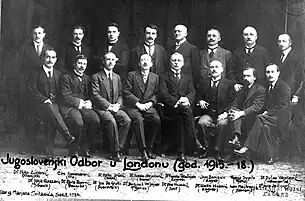Yugoslav Committee
Yugoslav Committee (Serbo-Croatian Latin: Jugoslavenski/Jugoslovenski odbor) was a political interest group formed by South Slavs from Austria-Hungary during World War I aimed at joining the existing south Slavic nations in an independent state.[1]

Formation
Founding members included:
- Frano Supilo[2][3][4]
- Ante Trumbić[2][3]
- Ivan Meštrović[2]
- Hinko Hinković[5]
- Franko Potočnjak[6]
- Nikola Stojanović[7][8]
- Dušan Vasiljević[9]
Supilo, Trumbić and Meštrović were Croats from the Kingdom of Dalmatia, Hinković and Potočnjak were Croats from the Kingdom of Croatia-Slavonia, while Stojanović and Vasiljević were Serbs from Bosnia and Herzegovina.[8]
History
Yugoslav Committee's initial gathering happened in late 1914 in Florence[2] while the committee was officially formed on 30 April 1915 in the Parisian Hôtel Madison. As Britain was the leader of the Entente, London was chosen as the headquarters of the Committee. The president was Ante Trumbić.[1][10]
In 1915, there were 17 members in the Committee, of which 11 were from the Croatian and Dalmatian littoral regions. During that year, the Committee formed branches in Paris, Geneva, St. Peterburg, Cleveland, Valparaiso and Washington. Their liaisons in the homeland were the United Yugoslav Youth, an illegal youth organisation formed in 1914 in Vienna (within Austria-Hungary), and the Government of the Kingdom of Serbia. Their relationship with the Serbian official politics was seen by the Committee members as necessary, but strained because of their occasionally conflicting political stances.[1]
The Committee reacted negatively to Nikola Pašić's government open courting of Italy in 1916, which had said that Serbia recognized the Italian hegemony over the Adriatic and particularly the naval bases.[11] Later the same year, they learnt of a memorandum by the Serbian government to the British where they explicitly staked a claim on various territories of Austria-Hungary where there were Serbian Orthodox monasteries. However, they could not come to an agreement on that issue, and Frano Supilo left the Yugoslav Committee on 5 June 1916. He died the following year.[1]
The committee signed the Corfu Declaration with the Kingdom of Serbia in 1917.[4] It was a compromise declaration, advocating a parliamentary monarchy, with three nations and two alphabets equal before the law, religious freedom and universal suffrage. It received political sponsorship of Great Britain and France. [3][11]
In October 1918, the State of Slovenes, Croats and Serbs was declared from the liberated lands from the Austro-Hungarian Empire in what would become the first incarnation of a Yugoslav state. This did not achieve recognition. In December, the State united with the Kingdom of Serbia (which had just expanded its borders after World War I to incorporate the Vojvodina region, and previously independent Montenegro) to form the Kingdom of Serbs, Croats and Slovenes. The Committee's task was accomplished.[12]
Ante Trumbić later became an opponent of the June 1921 Vidovdan Constitution and the new Kingdom of Yugoslavia (January 1929). Ivan Meštrović refused to participate in state politics and committed himself to his art. He left the country permanently in 1942.
See also
References
- Norka Machiedo Mladinić (June 2007). "Prilog proučavanju djelovanja Ivana Meštrovića u Jugoslavenskom odboru" (PDF). Journal of Contemporary History (in Croatian). Zagreb, Croatia: Croatian Institute of History. 39 (1). Retrieved 2012-02-27.
- Dejan Djokić (2023). A Concise History of Serbia. Cambridge University Press. pp. 348–350. ISBN 978-1-107-02838-8.
- Grlica, George (1973-07-01). "Trumbić's Policy and Croatian National Interests from 1914 to the Beginning of 1918". Journal of Croatian Studies. 14/15: 74–112. doi:10.5840/jcroatstud1973/7414/153.
- Drapac, Vesna (2010-01-27). Constructing Yugoslavia: A Transnational History. Bloomsbury Publishing. ISBN 978-1-350-30733-9.
- Jezernik, Božidar (2023-07-14). Yugoslavia without Yugoslavs: The History of a National Idea. Berghahn Books. ISBN 978-1-80539-044-2.
- Calic, Marie-Janine (2019-02-15). A History of Yugoslavia. Purdue University Press. ISBN 978-1-61249-564-4.
- Mitrović, Andrej (2007). Serbia's Great War, 1914-1918. Purdue University Press. ISBN 978-1-55753-476-7.
- Carmichael, Cathie (2015-07-02). A Concise History of Bosnia. Cambridge University Press. ISBN 978-1-107-01615-6.
- Congress, United States (1957). Congressional Record: Proceedings and Debates of the ... Congress. U.S. Government Printing Office.
- "Yugoslav Committee | Yugoslavian history | Britannica". www.britannica.com. Retrieved 2023-10-13.
- Singleton, Frederick Bernard (1985-03-21). A Short History of the Yugoslav Peoples. Cambridge University Press. ISBN 978-0-521-27485-2.
- Barbara, University of California, Santa; Studies, University of California, Los Angeles Center for Russian and East European (1980). The Creation of Yugoslavia, 1914-1918. Clio Books. ISBN 978-0-87436-253-4.
{{cite book}}: CS1 maint: multiple names: authors list (link)